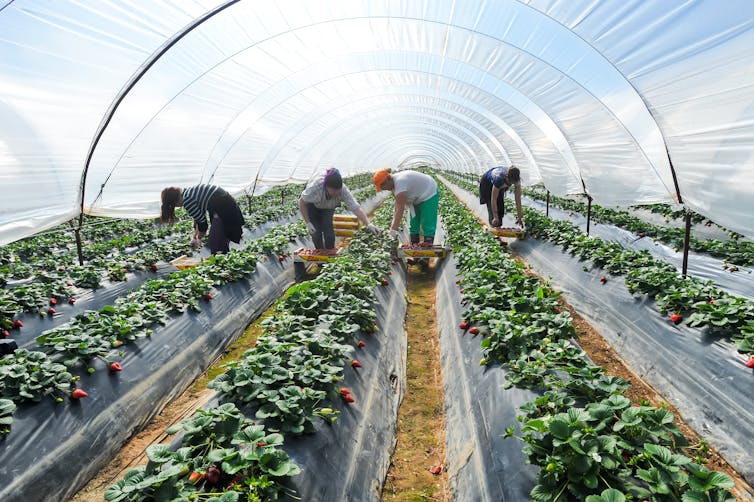Digital technologies are changing how food is produced. And it’s more than harvesting robots that are arriving on the scene. Companies are now pairing data centres with greenhouses, capturing the heat emitted by computing hardware and reusing it to grow crops indoors.
The new QScale data centre development in Lévis, Que. is one such project. The company claims that it will “produce 2,800 tonnes of small fruit and more than 80,000 tonnes of tomatoes per year” in greenhouses to be constructed adjacent to the facility.
In promotional campaigns, QScale picks up on the growing public attention to make food systems more local amid supply chain disruptions and rising grocery costs.
As social scientists researching the environmental footprint of digital technologies, we’re interested in the potential benefits and drawbacks of this new emerging connection.
Data centres coming in hot
Every time we access content online — whether it is a video or the latest social media post — it is sent to our device by a different computer, usually located in a large data centre. Also known as a “server farm,” a data centre is typically a warehouse-like building that hosts hundreds of computer servers that store, process and transmit big swaths of data.
Read more: 'Dark data' is killing the planet – we need digital decarbonisation
Data centres are increasingly criticized for their carbon footprint. The majority of emissions result from manufacturing the hardware they use. Servers also run day and night, continuously consuming energy and emitting heat. Backup generators guarantee uninterrupted data flow.

Temperature and humidity levels must be constantly monitored and controlled for the hardware to function efficiently and reliably. Data centres also have high water demands for cooling purposes, so they are especially contentious in dry areas.
To bring energy consumption and costs down, data centre operators are increasingly looking to locate their facilities in regions with a cold climate, which often also provide access to low-priced hydropower — both are part of QScale’s sustainability strategy.
In addition, the industry is now viewing “waste heat” as a valuable resource and opportunity to increase its sustainability score. Existing examples of heat recycling from data centres include heating residential buildings and swimming pools. Now, so-called “organic data centres” propose to leverage waste heat for food production.
Agricultural land re-zoned for data centres
QScale’s Lévis data centre is a $867 million development, financed by both public and private capital. The Québec provincial government acts as both investor and shareholder.
The government’s investment in QScale is part of two strategic goals: Supporting the province’s status as a hub for artificial intelligence (which relies on data centre services and is especially energy intensive) and doubling the volume of greenhouse food production by 2025.
Read more: It takes a lot of energy for machines to learn – here's why AI is so power-hungry
For QScale, pairing the data centre with greenhouses is important to position itself in the public debate as “greener” and locally owned in opposition to the multinational competition.
For instance, Google’s new data centre development in Beauharnois near Montréal will reportedly not include heat recycling and is also built on land originally zoned for agriculture, which is highly controversial.
When new buildings cover valuable agricultural land, they seal soil — a vital resource for long-term food sufficiency that is already shrinking due to rezoning for urban sprawl. Soil sealing means that fertile land is covered by impermeable materials like concrete.
The Québec government’s intervention to rezone the land slated for Google’s data centre was heavily criticized by Québec’s farmers’ union, the Union des producteurs agricoles. The union’s spokesperson pointed out that the cultivable agricultural area is only two per cent of the province’s territory.
In QScale’s case, the city of Lévis purchased farmland located next to the data centre development. This land is slated to be re-sold to QScale or other parties to develop potential greenhouses. Through its envisioned heat recuperation for indoor agriculture, QScale aims to contribute to local food autonomy. Can this promise hold up?
Are greenhouses green?
Due to short growing seasons, Canada relies heavily on imported fruits and vegetables, especially in the winter. This dependence became clear to the public when the COVID-19 pandemic disrupted supply chains and highlighted the fragility of the global food system.
Climate change and extreme weather events pose additional challenges, which was especially evident in 2021 when a heat dome formed over British Columbia and devastating floods followed later that year.
Read more: B.C. floods reveal fragile food supply chains — 4 ways to manage the crisis now and in the future
Taking crop production out of the fields and into indoor controlled-environment agriculture (CEA) could make the domestic food system more resilient and ensure year-round access to fresh produce in Canada. Potential environmental benefits include reduced emissions from transportation and refrigeration, as well as more efficient land and water use and reduced reliance on agrochemical inputs.
However, CEA systems have high energy demands to control the temperature, humidity and lighting conditions all year round. For example, leafy vegetable vertical farms with artificial lighting consume 100 times more energy than those with natural sunlight.
Depending on the energy source of the local grid, CEA greenhouse gas emissions can outweigh their benefits. The produced crop variety is relatively small, meaning that it cannot fully cover the nutritional needs of a local population.
The economic sustainability of CEA is also open to question. It relies on venture capital investment that is currently drying up and a tech-start-up business model that may not be feasible for food production in the long run.
Who will tend to the data centre-greenhouse crops?
As it stands, agriculture in Canada and elsewhere relies on the low-paid, precarious work of seasonal migrants who are barred from unionizing and frequently face abuse.

Conditions in the greenhouse industry are not necessarily better. In 2021, temporary workers at Serres Demers, Québec’s largest greenhouse operator and potential partner for QScale, denounced unsanitary, crowded and dilapidated housing conditions.
While this situation has reportedly improved since it made media headlines, labour struggles for farm workers in greenhouses and fields persist.
Illusion Emploi, an advocacy organization for non-unionized workers in Québec, states that the problems at Serres Demers are representative of widespread labour issues in the industry. The organization implores the government to take action by enforcing labour standards, performing spontaneous inspections without prior notification of employers and ensuring that workers know their rights.
Complex implications
The benefits of integrating digital infrastructure and agriculture are not as clear-cut as their promoters suggest.
While recycling heat from data centres and thereby easing energy demands of greenhouses is certainly better than letting it go to waste, the complex implications of these two newly merging industries must not be overlooked.
If the continuing expansion of digital infrastructures is legitimized by adding greenhouses into the mix, it could conceal other issues at stake including the significant environmental and social impacts of hardware manufacturing, land use and labour.
Janna Frenzel receives funding from the Social Sciences and Humanities Research Council (SSHRC) of Canada and Concordia University.
Sarah-Louise Ruder receives funding from the Social Sciences and Humanities Research Council (SSHRC) of Canada, the University of British Columbia's Public Scholars Initiative, and Future Skills Centre Canada.
This article was originally published on The Conversation. Read the original article.







